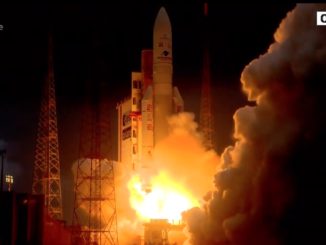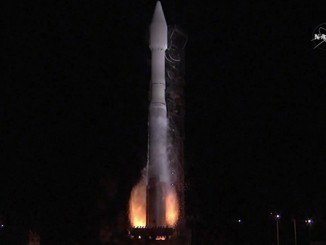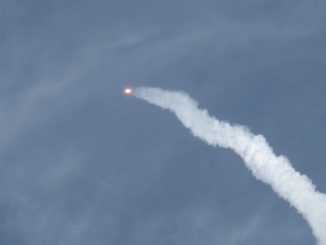
U.S. military officials and United Launch Alliance have dedicated the planned launch Saturday of an Atlas 5 rocket with the military’s winged mini-space shuttle to coronavirus first responders, front-line workers, and victims of the disease.
The launch set for 8:24 a.m. EDT (1224 GMT) Saturday from Cape Canaveral will be part of the military’s “America Strong” campaign, joining a series of flyovers of cities nationwide by the Air Force Thunderbirds and Navy Blue Angels to salute health care professionals and coronavirus victims.
The Atlas 5 rocket is scheduled to deliver the unpiloted X-37B spaceplane to orbit carrying experiments for the military and NASA. The mission is codenamed USSF-7.
“The U.S. Space Force and United Launch Alliance salute each American serving on the frontlines in our fight against COVID-19,” said Gen. John Raymond, chief of space operations in the U.S. Space Force and commander of U.S. Space Command. “We are proud to dedicate the upcoming launch of USSF-7 to showcase American resolve and national unity during these challenging times.”
ULA also added a written tribute on the Atlas 5’s payload fairing.
“In memory of COVID-19 victims and tribute to all first responders and front-line workers — AMERICA STRONG,” the dedication says.
ULA, in partnership with the @SpaceForceDoD and @usairforce, is dedicating the #USSF7 launch to all those affected by #COVID19. A written dedication is affixed to the #AtlasV rocket’s payload fairing #AmericaStrong pic.twitter.com/6VVTHH0R3v
— ULA (@ulalaunch) May 15, 2020
“We are honored to collaborate with the U.S. Space Force and dedicate the USSF-7 mission to front-line responders and those affected by this global pandemic,” said Tory Bruno, president and CEO of United Launch Alliance, in a statement. “This launch provides us with a unique opportunity to honor those affected by COVID-19, and pay tribute to the hard working first responders who are selflessly supporting the nation during this difficult time.”
“We are proud to include the USSF-7 mission in the America Strong campaign honoring all those affected by and battling the COVID-19 pandemic,” said Col. Robert Bongiovi, director of the launch enterprise at the Space Force’s Space and Missile Systems Center.
Mission teams are proceeding with the launch Saturday while observing safety requirements, reducing on-site personnel, and ensuring physical distancing amid the pandemic.
“We have an obligation to keep space capabilities up and running for our nation,” Raymond said May 6 in a virtual webinar discussing the upcoming X-37B mission and other Space Force activities.
The mission marks the second national security launch since the establishment of the Space Force in December. The Space Force’s first major national security launch occurred in March, when a previous Atlas 5 rocket lofted a secure military communications satellite into orbit.
But Space Force officials have delayed other missions due to the pandemic.
The launch of a GPS navigation satellite was pushed back two months from April 29 to June 30 to allow time to ensure the safety of ground teams and spacecraft controllers during launch preparations and early activation of the satellite once it is in orbit. The GPS navigation network is healthy, officials said when they announced the delay, reducing pressure to launch the fresh satellite.
The Space Force’s third new-generation GPS 3-series satellite will take off from Cape Canaveral on top of a SpaceX Falcon 9 rocket.
The Kennedy Space Center and Cape Canaveral Air Force Station are not opening any public viewing sites for Saturday’s launch, or for the planned liftoff of a SpaceX Falcon 9 rocket from a neighboring launch pad Sunday.
“Everyone can view the launch from the safety of their home via livestream,” the Air Force said in a statement. “Residents in Florida near Cape Canaveral should follow state guidelines for traveling to beaches, and refrain from gathering in large groups.”
While the Space Force is overseeing the launch of the X-37B spaceplane, the vehicle itself remains the property of the Air Force. The Air Force has flown the two reusable X-37Bs, or Orbital Test Vehicles, in its inventory on five missions since 2010.
The Boeing-built vehicles measure more than 29 feet (8.9 meters) long, about a quarter the length of NASA’s space shuttle orbiters. The X-37Bs can fly in orbit for years thanks to a deployable solar array, and electrically-driven aerodynamic flight controls that replace the life-limited hydraulic systems on NASA’s space shuttle.
The most recent X-37B flight lasted 780 days — more than two years — breaking the record of the previous mission. The spaceplane re-entered the atmosphere and touched down on NASA’s Shuttle Landing Facility runway at the Kennedy Space Center, the same landing strip used by the space shuttle.
Secretary of the Air Force Barbara Barrett said May 6 the sixth X-37B mission will host more experiments than any of the program’s earlier flights.
The payloads include two NASA investigations to expose advanced materials and seeds to the space environment, and a small releasable satellite developed by Air Force Academy cadets. A Naval Research Laboratory experiment is also aboard the X-37B to assess technologies that could generate electricity from solar arrays and transmit the energy to the ground for terrestrial use, a revolutionary concept known as space-based solar power.
The X-37B is likely carrying additional classified experiments. A new feature on this mission is a service module mounted to the rear of the spaceplane. In a sign that the Pentagon wants to continue keeping part of the X-37Bs mission under wraps, images of the spaceplane before launch did not show the new service module section.
Email the author.
Follow Stephen Clark on Twitter: @StephenClark1.



